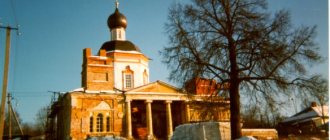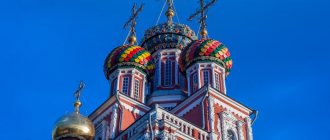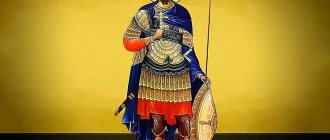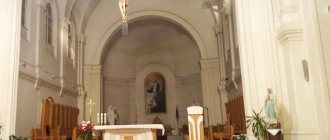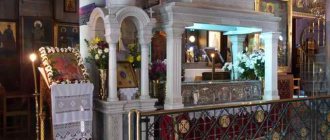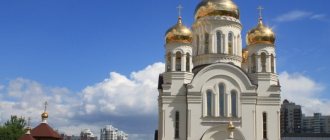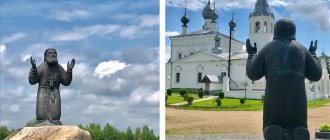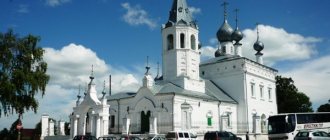Many saints and martyrs are honored in the Orthodox world, many are prayed to in various life circumstances, but there is one saint who, with a cross, a spear and a shield, stands guard over all the unfortunate and disadvantaged and carefully preserves the peace of his homeland. This is John the Warrior, especially revered by the Slavs, the patron saint of warriors, the protector of the offended and mourning. Many churches stand in his honor on Slavic soil, but in Moscow only one temple was consecrated in his glory. Welcome to John's Church on Yakimanka!
How the church was built
The Church of John the Warrior was first written about in 1625. In documents of that time it is called the “Temple of John the Warlord.” The wooden church stood on the right bank of the Moscow River, approximately in the place where the building of the Central House of Artists is now located. The low-lying coast created many problems. After the spring flood, the river was filled with meltwater, and the temple was flooded.
The Streltsy considered John the Warrior their patron, so in 1671 they demolished the dilapidated wooden church and built a new stone temple. At the end of the 18th century, the archers staged a revolt against the king. The young Tsar Peter I brutally suppressed the uprising and abolished all the Streltsy regiments. Some of the rioters were publicly executed at Lobnoye Mesto
, and the rest, along with their families, were evicted from the city. The Temple of St. John the Warrior was left unattended and empty.
In the summer of 1709, the river in Moscow overflowed so much that it flooded all the surrounding streets. According to legend, after the victory in the Battle of Poltava, Peter I returned to Moscow along the Kaluga road. On Yakimanka, a depressing sight appeared before the eyes of the king - an Orthodox church almost flooded with water.
When the emperor was told that this was the half-abandoned church of the martyr John the Warrior, he was very upset and ordered the construction of a new temple of stone, on a hill, next to the Great Road. A couple of months later, Peter I contributed 300 rubles for construction and brought a detailed drawing of the future church.
For the construction of a temple with a graveyard, a plot of land was allocated, which consisted of wasteland and the former lands of the disgraced archers. The design of the building was prepared by the Tsar’s favorite architect, Ivan Petrovich Zarudny, and the clergyman Alexei Fedorov took upon himself all the economic concerns.
In 1717 the new church was ready. On the day of its consecration, the sovereign presented the parish with a large painting with the text “A pharmacy that heals sins,” precious liturgical vessels and a heavy weight on an iron chain. So that the king’s unusual gift could be seen by everyone, the weight was hung near the entrance to the prayer hall.
Photo of the temple
St. John's Church is decorated at any time of the year.
You can admire this bright temple for a very long time.
Painted clock of the bell tower of the Church of St. John the Warrior on Yakimanka.
The Temple of St. John the Warrior on Yakimanka looks great at night.
Defender of all the offended
The saint, revered by believers, lived in the 4th century, when Christians were persecuted. John served the Roman Emperor Julian, but tried to help all Christians. For this, John was arrested and placed in prison. He managed to be released only after the death of the emperor. The defender of the first Christians led a pious life and managed to live to a ripe old age.
Church in the 19th-20th centuries
Zamoskvorechye was one of the richest districts of Moscow. Merchants lived here and willingly made donations to the temples. For this reason, by the middle of the 18th century, the welfare of the parish increased. The church became three-altared, and it was surrounded by a patterned forged fence on a solid brick foundation.
The famous Russian architect Vasily Bazhenov made a new iconostasis in the church, and the painter Gavriil Domozhirov painted the walls with multi-colored frescoes. Unfortunately, the early decor of the Church of St. John the Warrior was lost in the 19th century.
The war with the French in 1812 caused great damage to the temple, as well as to the entire city. French soldiers broke down the locked gates and brought their horses into the church. Fortunately, the enemies did not get the precious liturgical vessels. They managed to hide them in the basement under the altar before Napoleon’s troops arrived in Moscow.
The severe fire that engulfed the city also spared the ancient temple. The flame burned almost all the houses on Yakimanka and in the surrounding alleys, but stopped right in front of the church gates.
After the enemy left, all the thrones were consecrated anew. Thanks to rich donations and the efforts of parishioners, the interior of the temple and the lost utensils were quickly restored.
At the beginning of the last century, Archpriest Christopher (Nadezhdin) became the rector of the church. Under him, the temple celebrated its 200th anniversary. The solemn service was conducted for the parishioners by Metropolitan Vladimir of Moscow.
After the revolution, the church continued to remain active. In the 1920s to the territory of Russia
famine struck. Residents of the villages of the Volga region suffered especially hard, so the government of the young country decided to conduct a campaign to confiscate church valuables. Gold, silver and works of art were sold abroad, and the proceeds were used to buy bread for the hungry.
In 1922, a denunciation was written against Archpriest Christopher. The rector of the temple was accused of resisting the authorities, not wanting to hand over liturgical utensils from the Church of St. John the Warrior, and supporting Patriarch Tikhon in everything. At the end of March, the priest was arrested, and in June he was shot by the verdict of a revolutionary military tribunal.
During the years of the active struggle of the Soviet regime against religion, valuables from closed churches and monasteries in Moscow
and
the Kremlin
.
At this time, two icons that previously decorated the niches of the Nikolskaya
and
Spasskaya towers
of the Kremlin came here.
In 1928, a luxurious five-tiered iconostasis from the demolished Church of the Three Saints near the Red Gate was installed in the building. A little later, ancient icons from the Church of St. Maron the Hermit and the Church of the Intercession
on
Red Square
and the blown up Kazan Cathedral on Kaluga Square.
Icon John the Warrior
The Monk John was born at the end of the sixteenth century into a very devout family. Not many people know the meaning of the name John. In Greek, this name is translated as “Yahweh” - the Most High, the Lord's mercy. Thanks to the act of self-sacrifice and grace in the name of other people in need of support, which probably determined the popularity and love of this name in Christian families. In our article you can familiarize yourself with the brief life of the Great Martyr, and also find out what role the icon of the Saint plays in Christianity, and in what cases people ask for help in front of it.
Brief information about the life of John the Warrior
Great Martyr John the Warrior served in the government army of Tsar Julian the Apostate for two years. The holy martyr, unlike other fighters, had to not only hunt down, but also destroy Christian people. But he was such a cruel persecutor only outwardly, but in fact, the Holy Elder personally helped outcast Christians, warning them all about the upcoming dangers, in addition, he released the Orthodox who were languishing in prison and helped them escape.
The saint supported not only Orthodox believers, but also all those who were weak and asking for help, giving consolation to those who were sad or had various physical illnesses.
When rumors about his activities reached King Julian, he immediately ordered the Holy Elder to be thrown into prison. But some time later, the emperor was killed during the Persian battle, and John was released, and until the end of his days the warrior began to live in righteousness and praise of Jesus, and also helped all those who suffered.
The Holy Elder died at a very old age, but no one knows the exact date of his death, as well as the place where he was buried. Only a couple of years later, John came to one righteous resident of the city in a dream and showed him his resting place.
After their discovery, the remains of John the Warrior were sent for storage to the Cathedral of St. John the Evangelist. The relics of the Holy Warrior, like most relics of Orthodox martyrs, have the ability to heal all the weak and sick. A prayer read before his face can give consolation to all believers who are consumed by resentment or longing for a lost loved one.
In Christian churches, the Holy Elder is praised as one of the great Orthodox patrons who protect and help people overcome grief and obstacles on the path of life. Dear Friends, we remind you that on our website you can easily and extremely inexpensively buy an icon of John the Warrior at the lowest price!
Day of Veneration of the Icon of John the Warrior
The Christian church calendar sets a date for the veneration of this Holy Warrior, which is celebrated every year on the twelfth of August (the thirtieth of July according to the old style).
Meanings of the Holy Image of the Wonderworker
Of all the Christian Great Martyrs, who are the heavenly protectors of believers, the most beloved and famous face is the icon of John the Warrior. Throughout his entire earthly life, this Saint protected his Fatherland and people who risked their lives in the line of duty.
What do they pray for in front of the icon?
In ancient times, when serfdom had not yet been abolished, most people were confident that if they asked the Miracle Worker through prayer, he would help catch a robber with all his loot or find an escaped serf, while countless historical evidence has been preserved confirming miraculous deeds .
During the occurrence of any misfortune with loved ones, in order to help them cope with this trouble, you need to pray to John the Warrior, but in order for him to help you, you must adhere to one condition: your prayer request must come from the heart, and your thoughts must be pure.
In fact, all the robbers were very afraid of John the Warrior during the times of Kievan Rus. When someone was suspected of theft, those around them immediately brought the suspect to the icon of the Saint, and out of awe before the Warrior, the robbers almost always admitted to theft.
On what occasions do they pray to the Holy Martyr:
Most people are confident that things stolen by thieves will never be found again. But there are people who say a prayer request and miraculously the stolen things or valuables are returned to them. Because the Heavenly Warrior from ancient times to the present day protects all the offended and weak. • Parents who accompany their children to the service read a prayer in front of the icon to protect them from death and troubles; • They pray to the Holy Warrior for the purpose of protection from enemies; • The Elder hears prayers and sends help to those who are held in captivity or captivity; • He can help find lost things; • In cases of mental sadness or other difficult circumstances, you can also ask for help from the Heavenly Warrior.
How to correctly read prayers in front of the face of John the Warrior
To pray to the Holy Warrior, you can read one of the specific prayers that are most suitable for overcoming difficulties in the life of the person who has converted. But first you need to find spiritual harmony and focus on worshiping the Lord by saying the following prayer:
“The Most High Jesus Christ, Son of the Lord, for the sake of the requests of the Most Pure Mother of God and all the heavenly powers, have mercy on us. Amen” and then slowly and calmly read the prayer clearly:
“Oh Holy Martyr of God John, champion of Christian people, drive away offenders and protector of the weak! Hear us, who in misfortune and sorrow turn to you, how you have been granted mercy from the Almighty: to console the sad, to help the sick, to protect the innocent from a vain death, and to ask the Lord for all the weak and needy. Be you a strong protector for us from all our visible and invisible enemies, as with your help and protection all the evil forces that appear to us will fear us. Ask Jesus Christ that we, sinful and unworthy servants of God (names), may be worthy to receive heavenly blessings from the Lord, as we have prepared, praising Him, glorifying the Lord in the Life-Giving Trinity, constantly, now and always, and forever and ever. Amen."
But to find lost things you need to think only positively. Before reading the prayer, there is no need to send curses or be angry with the person who harmed you; you must be merciful and ready to forgive your offender.
Before turning to the Great Martyr, for example, before praying for the return of funds, you must say the “Our Father” prayer. All this is done in order to first pray to the Lord, beg for forgiveness of all your sins, conscious or unconscious, and only after that can you say a personal prayer. Moreover, the prayer request will sound most powerfully in a Christian church in front of divine icons.
A prayer is also said to the monk to search for the stolen property. You just need to mentally imagine the stolen items, think about finding them, say the “Our Father” prayer and pray to the Wonderworker, and according to legend, after some time the stolen property will return to the owner.
You can also order an Akathist at church; this can add power to the spoken prayer at home.
We also remind you that our Orthodox store will help you find many other Orthodox goods, and even buy temple icons!
Architectural features
The ancient church can be considered one of the most beautiful cathedrals and temples in Moscow. The architecture of the temple on Yakimanka harmoniously intertwines the best traditions of Ukrainian and Moscow baroque. A close look at the colorful “gingerbread” facades reveals the influence of European architecture, which appeared in Russia during the reign of Peter I.
The bright red and white building is built like a “ship” - the bell tower, refectory and temple are stretched in one line from west to east. The plasticity of the temple is very expressive. The building is decorated with figured platbands, carved cornices, balusters, pilasters and neat small balconies.
The base of the temple - an octagon on a quadrangle - has an original engineering solution that resembles an elegant rotunda. The high bell tower ends with an octagonal drum, and openwork crosses adorn the faceted gilded domes.
The temple area is surrounded by a beautiful metal fence on brick pillars. Above the entrance gate you can see a large mosaic depicting the martyr John the Warrior.
Schedule of services in the Church of St. John the Warrior on Yakimanka
Traditionally, in the Church of the Martyr John the Warrior on Yakimanka, they adhere to the established order of services.
| Daily | 08:00 17:00 | — Morning service, Divine Liturgy; — Evening, Morning services |
| Sundays and major holidays | 07:00 10:00 | — Early Divine Liturgy; — Divine Late Liturgy |
On the eve of Sundays and great holidays, as a rule, an All-Night Vigil (the service begins at 17:00).
From the beginning of June to the end of August, the summer schedule of services operates.
| Monday, Tuesday, Wednesday | 08:00 | — Morning service, Divine Liturgy |
| Thursday, Friday, Saturday | 08:00 17:00 | — Morning service, Divine Liturgy; — Evening, Morning services |
| Sunday | 09:00 17:00 | — Divine Liturgy — Evening, Morning services |
| Great Holidays | 07:00 10:00 | — Early Divine Liturgy; — Late Divine Liturgy |
On the eve of great holidays, as a rule, an All-Night Vigil (the service begins at 17:00).
Interiors and shrines
Inside the church is very spacious, bright and looks like a precious box. It is richly decorated with figured stucco molding, ornaments and frescoes.
The magnificent carved iconostasis has five tiers and shines with noble gold. The future poet Mikhail Lermontov was baptized near this iconostasis. The funeral ceremonies of the famous general Mikhail Skobelev, the talented pianist Svyatoslav Teofilovich Richter and the composer Alfred Garrievich Schnittke were performed here.
Church of St. John the Warrior with three altars. The main altar is dedicated to John the Warrior, the southern chapel is consecrated in memory of the Christian martyrs Samon, Aviv and Guria, and the northern chapel is in honor of Bishop Demetrius of Rostov. The main shrine is considered to be the temple image of John the Warrior, which was painted in the mid-17th century.
Many believers come to pray before the icon of St. Barbara, which came here from the Church of Barbara the Great Martyr on Varvarka. A separate chapel was built for this image in the church. The icons and reliquaries in the altar contain particles of the relics of more than 150 saints. During Christian holidays they are brought to believers.
Just a stone's throw
Do we know the shrines in our hometowns? Having asked this question back in the days when the belt of the Most Holy Theotokos was in Moscow, we sent Marina Vologzhanina to look for answers in one monastery and four Moscow churches.
John the Baptist Convent
John the Baptist Convent. Photo: temples.ru
In the thick morning twilight, which haunts cloudy Moscow for a long time, I walk along an alley that slopes steeply down from Maroseyka. The weather is so-so for a walk, but for a pilgrimage it’s just what you need: heavy low clouds are pouring down either rain or snow. Judging by the package, a gray-bearded priest is heading in the opposite direction from the monastery refectory tents.
It's all temples here. On the left hand rises a white one - the Church of Equal-to-the-Apostles Prince Vladimir in the Old Gardens, near which roses do not wither for so long in the fall, and at the end of the alley that dives into Zabelin Street, the walls of my current goal - St. John the Baptist Monastery, one of the oldest Moscow monasteries, turn yellow.
Here, by decree of Empress Elizabeth Petrovna, the terrible Saltychikha was once kept in an underground prison - in complete darkness, only lighting a candle for her at a meager meal. And only ten years later they transferred her to a cell connected to the monastery church by a window, the green curtain of which was pulled back by the Moscow people who came to “look” at the prisoner.
Then the daughter of Elizaveta Petrovna herself was exiled here. This exiled woman became a saint.
“During the reign of Catherine the Great - as they say, in 1784, under Abbess Elizabeth - a nun entered the monastery by imperial decree, whose identity is still a mystery in Russian history. This was the nun Dosithea, who, as historians believe, was the daughter of Empress Elizabeth Petrovna from a secret but legal marriage with Alexei Grigorievich Razumovsky,” we read about her in the book “Moscow St. John the Baptist Convent. Pages of history." Through the Novospassky elders, with whom the recluse was in spiritual communion, the author writes, “a thread was reached to her, connecting Russian monasticism with the Athonite monastic ideal.”
Today this monastery, which had already experienced both closure and revival once – in the 19th century – is once again gaining strength. Muscovites come and go here – both for services and simply to visit shrines. My friend Anastasia Andreevna - “to the hoop.”
The hoop is in the chapel, attached with a chain to a copy of the ancient image of John the Baptist, lies in a casket on a pillow - those who wish put it on their head. Nearby are several laminated paper sheets: a troparion and a prayer. There's oil here too. There is a paper sign near the oil: “Brothers and sisters, it is blessed to anoint only the forehead.”
The ancient image itself with a particle of the relics of the holy Prophet, Forerunner and Baptist of the Lord John - the same one that was already 100 years old when in the middle of the 17th century it was carried around Moscow in royal processions of the cross - is in the cathedral, but where exactly, for some reason one has to ask I don't dare.
The cathedral is semi-dark and quiet. A nun passes and silently disappears. I look around. In the right aisle, Kazanskaya is calling and flickering from the darkness. An image with particles of relics. Here is St. Seraphim. Tomb. There are dry and pale rose petals on the marble lid, and when you touch them, you feel the smell. This is the tomb of the blessed schema-nun Martha, who labored here during the time of the first of the Romanovs. You bow as you would to beloved relatives: hello! And you are here, and you - how great! - oh, and you! Here is the icon of the Great Martyr Anastasia the Pattern Maker with a particle of relics, and here is St. Nicholas, and here are our recent ones from Diveyevo: Blessed Pelagia, Paraskeva, Mary. And each one - in full accordance with the recommendations on the sign - seems to anoint your forehead, and something appears in the air, it thickens and as if it itself becomes oil.
But the image of the Baptist of the Lord is not found, that’s the point! Therefore, the laminated troparion was not enough for me. I'm going to the candle holder. “How come you didn’t see it? Up the stairs - at Kazanskaya!”
There he is. Appears in the twilight over the salt, glowing with dark paint. The most incomprehensible of the saints for me is the half-angel.
I take the canon out of my backpack and go read under the lamp.
Temple of John the Warrior on Yakimanka
Further, down Solyanka: Moscow streets here are like waves. On the left abeam is the bell tower of the Church of the Life-Giving Trinity in Serebryaniki, behind it (in the mind’s eye) is your favorite route: the takeoff of Goncharnaya Street to Shvivaya Gorka to the courtyard of the Athos Panteleimon Monastery. But today we have other goals: the ancient shrines of Moscow.
Temple of John the Warrior on Yakimanka. Photo: sobory.ru
I'm going down to the subway. Two stations and I’m on Yakimanka. The Temple of St. John the Warrior - the elder “brother” of St. Nicholas in Khamovniki - is festive, impossibly beautiful: Russian baroque.
It was never closed.
In 1922, the rector, the dean of Zamoskvorechye, Father Christopher, was shot, all the utensils were confiscated, and then suddenly, on the contrary, they began to bring images and shrines here from closed Moscow churches. And the icon of the righteous Joachim and Anna with 80 hagiographic stamps from the temple that gave the name to the street Yakimanka, and the icon of St. Basil the Blessed from the temple named after him on Red Square, and from the same place, from the square, the icons of the All-Merciful Savior of Smolensk and St. Nicholas the Wonderworker, which were previously located above the gates of the Kremlin, and the relics and icon of the Holy Great Martyr Barbara from the temple of her name, which is on Varvarka.
The executed rector was glorified in 2000 among the host of new martyrs and confessors of Russia, and all this past and present breathes and lives here, you can feel it, you can’t help but feel it as soon as you enter the church.
I’m looking for an icon of the Great Martyr Barbara with part of a finger... But of course they don’t go to shrines with the attitude: “show me quickly, I need to go to three more places”: it turns out to be an excursion. If only I could read the akathist... And for the second time that day I get a little tap on the nose: access is blocked - the temple is being removed. The asked granny kindly shuffles from the candlestick to the benches, which block the icons of the Great Martyr Barbara from me, and points from afar: “There is the head, and there is another icon, see? On the left, in the icon case.” The relics are in the altar and taken out on holidays.
Eh! For some reason I’m going to the church shop. When I asked for an inexpensive book about the church, I received “The Life and Ministry of Archpriest Alexander Voskresensky (1875–1950).” From the cover of a sparse print one can see a white-orange-green church and an old-fashioned priest and mother. I'm scrolling through, looking for pictures. The first to come across is a familiar face - Metropolitan Veniamin (Fedchenkov) and a facsimile of the reverse side of the photograph: “To the venerable Archpriest, dear Father Alexander, in prayerful memory and in gratitude for the deceased brother Sergius and living sister Nadezhda.”
The mysterious, hidden, “small” history of the Russian Church is revealed in such books that their devoted children like to publish in parishes about their dear and beloved fathers.
Cathedral of Christ the Savior
The queue to the Cathedral of Christ the Savior during the days when the Belt of the Blessed Virgin Mary was in Moscow
The question is: how to get from Yakimanka to the Cathedral of Christ the Savior? The obvious answer: by metro. But I need a non-obvious one: I feel that the situation urgently needs to be corrected, otherwise everything there will be closed, and I decide to work hard - to go on foot, focusing on the mast of the monument to Peter the Great: so it came in handy.
Forward and down - to the river. Again, a crooked lane, Muzeon Park, behind the fence - melted snow, sculptures, crows, children. I’m looking forward to a spectacular insert about the sculptures, but the horns: the woman at the entrance demands payment... We won’t go there for money, we flow around to the right. Behind the Yauza, the red brick Art Strelka is already flaunting with all its might, the smell of fresh coffee, and I am heading towards the Patriarchal Bridge and, looking at the rippling Moscow river water, I remember when I saw it two previous times: both framed by a crowd. In the photographs, from the queue to the belt of the Virgin Mary and almost in the same place, but on the other bank - on Bolotnaya.
On the bridge, street cleaners, lined up in a chain, scrape the ice, a girl takes photographs of the temple from different points, a man walking towards you from the main gate, for some reason, only here puts his large bags on the ground, takes off his hat and, raising his head to the domes, fervently crosses himself three times.
Inside, the audience is increasingly non-church, only getting closer; to the left of the iconostasis is a swarm. Mostly aunties; stoles are wound over the trousers. “Why is there a queue?” - asks an elderly man standing in the back. “To the robe of the Most Holy Theotokos,” they whisper to him, “and also the relics of the saints there.” The man remains standing. Some girl decides to consecrate, apparently, the icon on the relics and - bang! – puts the handbag on the shrine. It’s a second of horror, but the woman in the stole reacts like a professional security guard, that is, instantly and without emotion: she almost silently jumps forward, touches the girl by the elbow and waves her hand: “take it away, take it away.”
There are many shrines here - in this huge temple, where all of Orthodox Moscow recently stood in line. A piece of the robe of our Lord and Savior Jesus Christ, the relics of the founder of the temple, Metropolitan Philaret of Moscow, transferred here in 2004 with the blessing of His Holiness Patriarch Alexy II from the Trinity-Sergius Lavra, a piece of the relics of the Venerable Mary of Egypt, the miraculous Vladimir image of the Mother of God and the miraculous Smolensk-Ustyuzhensky...
I kiss the robe of the Mother of God, go down to the lower Church of the Transfiguration, where the ancient Smolensk icon and the unusual image of St. Nicholas, brought from Bari, are located, and flow out into the street. The next point on the route is the Temple of Elijah the Prophet in Obydensky Lane. Now everyone probably already knows that there is a piece of the belt of the Blessed Virgin Mary there.
Transition
Moscow, of course, is a city of contrasts. At the crossing to Ostozhenka there is a simple young woman for some reason with a Yorkie under her arm. Black hair from under a hat, over trousers - something like a black stole, but given the presence of a dog, I understand that the girl is not coming from the temple - it’s just an outfit.
I am an acquaintance with her. I don’t listen, but it hits me on its own – sharply, like the sound of a siren: “Well, no, I won’t go to the red light, only idiots go to the red light.” That’s how I lost my child: the stroller moved and that’s it,” sounds a hoarse voice. My friend, like me, doesn’t get it right away. She continues to rattle on, but suddenly interrupts herself: “How did you lose it?!” At all?" “And like this,” she answers, taking a drag, and with a click shoots the bull into a puddle, “absolutely.” Died". They step forward sharply - the light turns green.
Temple of Elijah the Prophet in Obydensky Lane
Temple of Elijah the Prophet in Obydensky Lane. Photo: sobory.ru
The people behind the glass at Vanilla are looking at passers-by, a couple of passers-by are looking at the entrance and the menu. Okay, but where is Obydensky Lane? A fashionable hairdressing salon, behind the glass they cut and dye women's hair, then the Genatsvale restaurant, almost reached Zachatievsky. You have to ask the locals - there seems to be a guy in pulled-up pants, not glamorous, but he just shrugs: “Elijah the Prophet?” - and, in order to do at least something good for me, he points to the Conception Monastery: well, there’s the temple...
I turn around: maybe that old lady is an aborigine? She shakes her head: she is looking for “one institution.” Where have all the residents of this street gone? Evicted to Kapotnya? Girls hurry past for lunch.
Finally hooray! – two nuns walk towards you, chatting decorously. "Mother! - I rush to them, like Semyon Farada in the film “Sorcerers”, “can you tell me where the temple of Elijah the Prophet is?” Mothers are in no hurry. “It’s not visible from Ostozhenka,” the younger one slowly explains, “you need to go back to the beginning.”
Certainly! Here he is, pulling the golden cross of his high bell tower into the gray sky.
At first, the temple of the Holy Prophet of God Elijah, built in one day (that’s what the word “ordinary” means, it turns out) and which gave the name to the local alleys, was wooden: the stone one was built only in 1702 by the baroque architect Ivan Zaprudny.
This temple was also never closed, and here it feels like home.
Between "Milostiva" and Golgotha, a homeless man in a black coat is dozing, sitting on a spacious bench - an open box of "Hercules" peeks out from an "Ashanov" bag.
On the lectern, in a wreath of white roses and lilies, is an icon of the Mother of God. The Virgin Mary holds the veil. The icon was consecrated on Mount Athos. Lilies and roses exude a delicate aroma.
Here is a piece of Her belt. Here - well, finally! - a particle of the relics of the Great Martyr Barbara, and my beloved Great Martyr Catherine, to whom I have an old debt: she knows - and the Prophet of God Nahum, whose memory is just today and to whom I, like a sheep, not understanding who it is, read in the morning rush troparion, and now he, even if he is not familiar, becomes familiar.
I go to the box to submit forty dollars for a relative. I hear my granny answering someone: “And this is our miraculous “Unexpected Joy.” I’ll also give it for my mother - this is what I suddenly come to an unexpected conclusion. In the vestibule, another grandmother explains on her mobile phone: “I gave it to Ilya Obydenny! What?! At the Ordinary! It would be nice to come here more often.
Church of the Resurrection of the Word on Uspensky Vrazhek
Two stations to Okhotny Ryad - and I’m already on Tverskaya. At Intourist there is a small crowd pressing against the fence: they are waiting for someone. “Now we’ll ask,” says the passerby and pulls her boyfriend by the hand towards the photographer with powerful optics, which he smokes while walking along the line, “who are they waiting for?” “McCartney,” he says. I'm passing by this little other planet. My Moscow is very different, everyone here has their own queues, their own expectations and their own lives.
Church of the Resurrection of the Word on Uspensky Vrazhek. Photo: sobory.ru
For example, for me, my next goal is precisely the church, although about all the others I say “temple”, and in my mind it is located not in Bryusov Lane, but on Galina Nezhdanova Street. “Church on Nezhdanova,” we said in the 1980s and understood each other perfectly, calling the never-closed Church of the Resurrection of the Word, which is on the Assumption Vrazhek.
Already in the 2000s, having somehow begun church life, I went here to “Seek the Lost.” No matter how you come, there is always - or almost always - some woman, stunned by grief, standing there and reading an akathist. Sometimes he sits on a bench and just watches. Or rather, it’s not easy. You can’t describe how. On the floor, on an icon or in front of you. The candles are crackling: there is not a single empty space in the candlestick at the “Recovery of the Dead.”
Then I read somewhere that here, to the icon of the Mother of God “Unexpected Joy”, Archimandrite John (Krestyankin) went to pray when coming to Moscow from Pechory. Today is the third discovery of an inattentive person: an ancient miraculous image of St. Spyridon of Trimifunt with a particle of relics.
The day before I found the following about him on the Internet - someone wrote on his blog: “One of the temple workers came to pray and ask Spiridon for help. She prays in front of the icon - and suddenly the ark with the relics of the saint, which is on the icon, opens. This made such a huge impression that everyone who was in the church at that moment came running to see this miracle; They called the priest and asked what to do about it. Father said: let the one who opened the door close it. What a surprise it was when the same worker prayed again and the door closed. Believe it or not, but this is the truth of life... That’s not what happens.” I don't even doubt it.
***
I left. The day continued outside. A giant Hyundai advertisement was dismantled on the building opposite the Central Telegraph. At Intourist, the thinned crowd was still waiting for McCartney.
Useful information for tourists and pilgrims
The doors of the temple are open on weekdays from 7:30 to 19:00, and on Sundays and holidays from 6:30 to 19:30. Divine services are held twice a day - at 8:00 and 17:00. There is a Sunday school for the children of the parishioners, and there is a youth choir. In addition, the temple holds classes for anyone who wants to learn to read in Church Slavonic.
